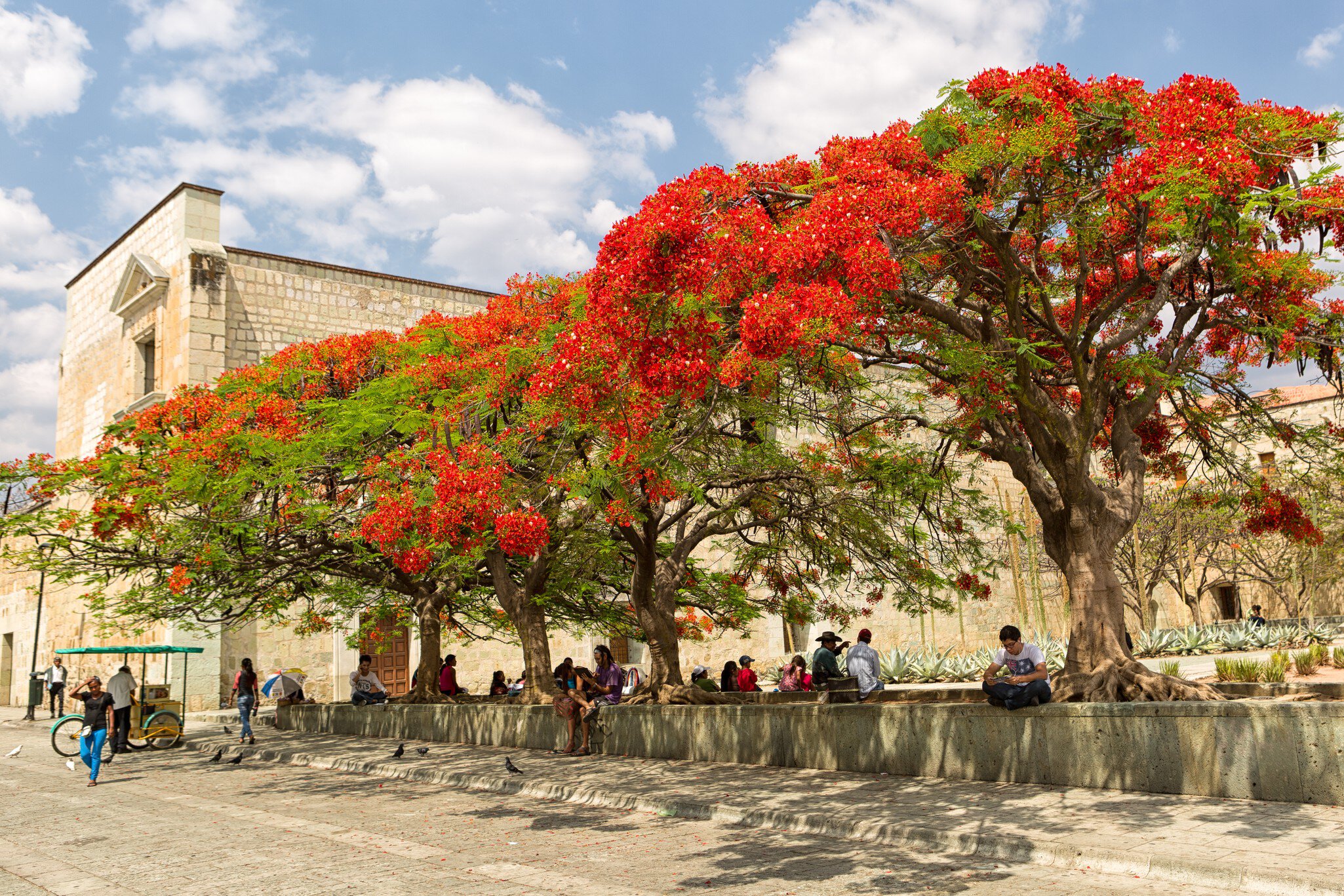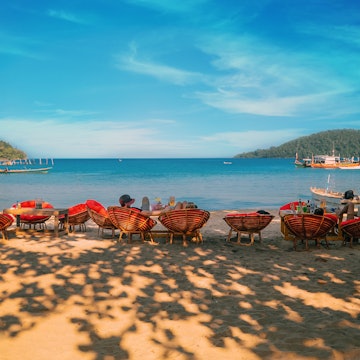
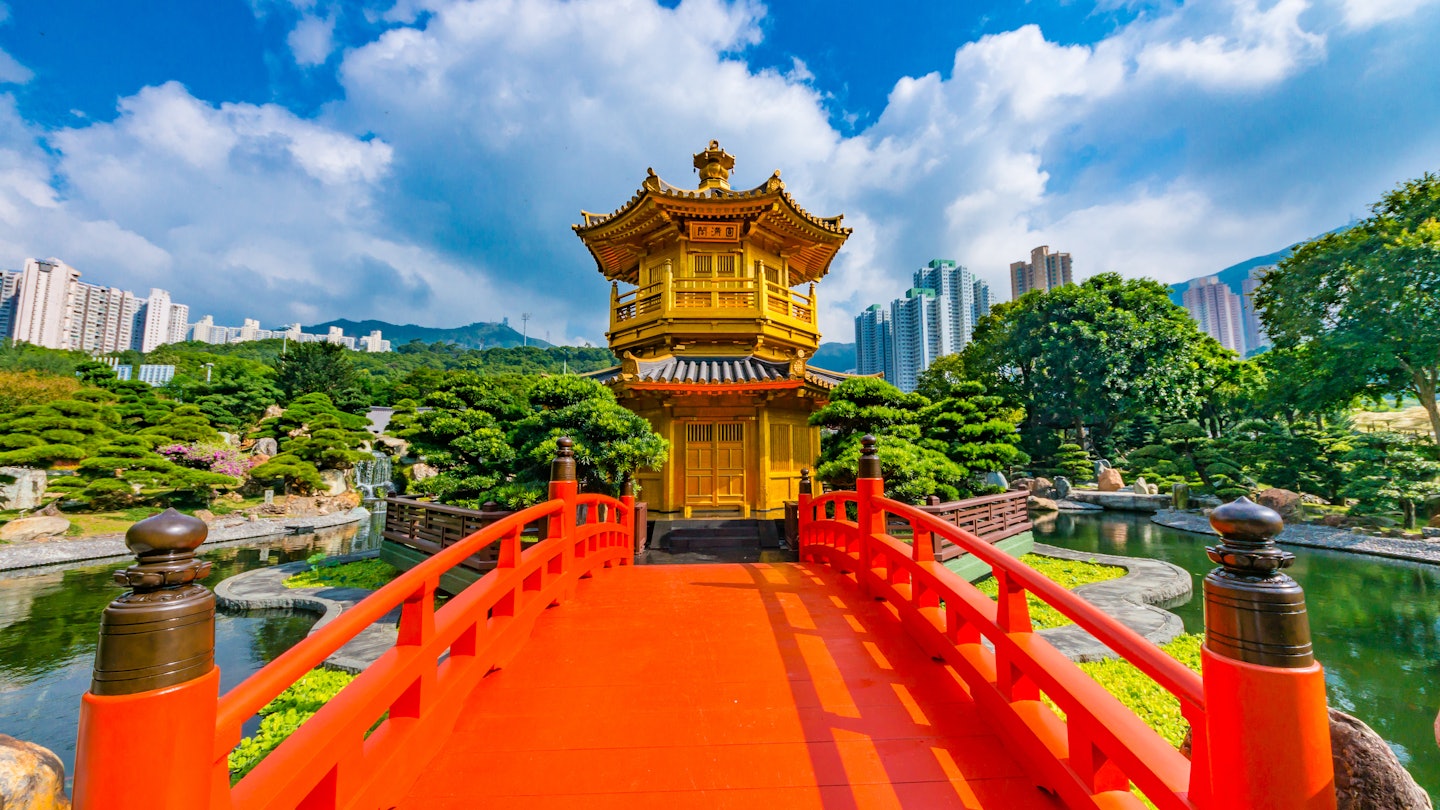
Nan Lian Garden in Hong Kong. pickbiz/Shutterstock
Travel across and you’ll have a lifetime of stories to share. The continent is massive – covering nearly a third of the earth’s land and housing more than half of the world’s population – and the experiences for visitors are equally vast: hiking the world’s tallest peaks in Nepal, snorkeling in the Indonesian archipelago dotted with thousands of islands, sleeping under the stars in Jordan’s Wadi Rum or biking Vietnam’s mountain loops.
Asia's attraction as a compelling destination lies in its incredible diversity, from sun-dappled beach towns to towering Himalayas, expansive deserts to historic old towns and futuristic cities. You can spend a weekend in humming Tokyo before napping on a remote island in Cambodia; switch from sipping hot chai on a buzzy street in north India to meditating to the faint murmur of mantras at a temple in Bhutan.
Wherever you go in Asia, you are in for a treat, whether it’s phenomenal dining, friendly people or diverse scenery. Plan well and learn and respect the local customs so you can embrace everything Asia has to offer. These are our recommendations for the best places to visit in Asia.

1. Luang Prabang, Laos
Best for absorbing the rhythm of local life
Luang Prabang wakes up before the sun, when hundreds of saffron-robed monks meditatively walk the town’s frangipani-studded lanes and bylanes while residents gather to offer alms. Forget maps because this is a town that really pulls at your heartstrings, shaped by the influences of Buddhism, royal dynasties, French colonial powers and generational artists tending to their crafts.
Meander the old town – which sits on a peninsula at the confluence of two rivers, the Mekong and Nam Khan – housing over 30 temples and monasteries alongside the city’s Royal Palace Museum. Spend your days sampling Lao cuisine and learning local weaving traditions at the Traditional Arts and Ethnology Centre before watching those stunning Mekong sunsets.
Detour: Make time for day trips to some of the best places in Laos. Perhaps you'll choose to swim in the cascading Tat Kuang Si falls; cruise the Mekong to the village of Ban Xang Hai, where residents distill their own alcohol; or head further afield to Pak Ou, where two riverfront limestone caves house hundreds of Buddha images.

2. Bangkok, Thailand
Best for urban variety
Bangkok has it all! We are talking about a Thai grandma wearing a floral bucket hat quietly sipping coffee next to a vintage magazine stall while the Sky Train (the city’s mass transit system) rides past some of Asia’s glitziest shopping malls. You could spend your morning aimlessly wandering streets lined with gilded Buddhist shrines, grab pour-over coffee from a bean-to-cup brew bar, then watch a street vendor toss up rice noodles for dinner. First-timers can’t skip the Grand Palace and the glistening Wat Pho, followed by feasting in Bangkok’s Chinatown or shopping at Chatuchak Weekend Market, where you’ll see everything from mango sticky rice to knitted sweaters.
Those who want to embrace the city’s rhythm can spend time exploring its neighborhoods, from the cosmopolitan Sukhumvit with its Michelin-star dining to the new cool kid on the block, Talat Noi, heaving with charming alleyways and restored warehouses transformed into hip cafes.
Detour: Take a day trip to the ancient city of Ayuthaya or cycle your way through the pottery village Ko Kret.

3. Angkor, Cambodia
Best for a monumental temple complex
No trip to Southeast Asia is complete without a visit to Angkor Wat, Cambodia’s national pride – even appearing on the country’s flag. This sprawling ancient temple complex built by the Khmer kings nearly 900 years ago soars above the tropical jungles with detailed bas reliefs, ascending towers and courtyards connected with elaborate walkways. Spend at least half a day on a guided tour wandering through the temple’s galleries, where thousands of ethereal apsaras (celestial figures) are carved into its walls and columns.
Planning tip: If you’ve more time, explore the other ornate Khmer temples that are part of the massive 400-sq-km Angkor Archaeological Park, which describes as a “unique concentration of features testifying to an exceptional civilization.”

4. Hoi An, Vietnam
Best for a magical UNESCO-listed town
Ask anyone who’s been to Vietnam and they’ll tell you that Hoi An is one of the most memorable places they’ve ever visited. Although recent years have seen the town overflow with tourists, Hoi An’s remarkably preserved, lantern-strung old town still feels as magical as ever. Apart from strolling the warmly lit alleyways of the atmospheric main drag past dozens of cafes and boutiques, and enjoying epic sunsets, cycle through the country roads that wrap around the waterways, passing through rice fields, markets and craft workshops. While nearby Danang has earned a reputation as one of Central Vietnam’s main beach spots, Hoi An’s beaches are great for a warm, sunny day by the sea.
Planning tip: Hoi An is also famous for custom-made clothes. There are more than 300 tailor shops here, and some even call it the tailoring capital of the world.

5. Hunza Valley, Pakistan
Best for mountain scenery with glacial-fed rivers
Snowcapped jagged peaks guard riverine valleys where cherry and apricot trees come to bloom in spring, and herds of yaks traverse the wildflower-dotted grassy meadows in summer. This is everyday life in Hunza Valley, a high-altitude region of northern Pakistan surrounded by some of the world’s tallest peaks in the Karakoram Mountains. Since the valley was cut off from the world for many years, the Hunzani people have maintained their distinctive culture, language and cuisine and often take pride in community-based schools, contributing to the region's 97% literacy rate, the highest in Pakistan.
Those who seek adventure can opt for a road trip along the Karakoram Highway – a 1300km route connecting Hasan Abdal near Pakistan’s capital, Islamabad, to China’s Kashgar. With trails to Rakaposhi and Nanga Parbat base camps, it’s truly a paradise for trekkers, but there are also plenty of other things to do, like wandering the lively Karimabad Bazar, hiking to glacial lakes and feasting on buckwheat pancakes and yak meat burgers.
Planning tip: A spike in tourism in recent years saw guesthouses and hotels open up in the Hunza Valley, and you can now fly into Gilgit, the nearest big city and also the gateway to the country’s remote northernmost region.

6. Jaipur, India
Best for a walled city with historic architecture
Almost everyone who visits India visits Jaipur. The Rajasthani capital – nicknamed India’s Pink City because most of its buildings are painted in pastel pinks – bursts with attractions: a majestic royal fort, flamboyant palaces and lively bazaars teeming with color. Roam the historic Old City guarded by massive gated walls; step inside Jaipur’s royal glory at the City Palace's museums, galleries and courtyards; and look through the latticed windows of the sandstone palace Hawa Mahal at sunset. You could spend hours at the Amber Fort, with its palaces, pavilions with mosaics of mirrors, and courtyard gardens.
Planning tip: Shop at the marketplaces in Jaipur’s Old City for hand block-printed clothes, artisanal jewelry and colorful footwear. Disclaimer: you might, like me, want to bring everything home!

7. Pokhara, Nepal
Best for recharging
A counterpoint to the bustle of Kathmandu, Pokhara is the perfect place to rest. Nepal’s second-largest city, set around Phewa Tal, offers breathtaking views of the Himalayas and is the ideal spot to recharge after weeks of trekking in the Annapurna circuit. But with temples, markets, laid-back cafes and family-run homestays, you can easily dive deep into Nepal’s heart and soul here.
Planning tip: If you still yearn for more adventure, there’s that too – you can paddle a rowboat on the lake, go whitewater rafting and even paragliding from Sarangkot Hill.

8. Ella, Sri Lanka
Best for an island adventure
Once a small village, Ella transformed into Sri Lanka’s adventure hub in the past decade. At sunrise and sunset, crowds frequent Little Adam’s Peak, which overlooks the overgrown craggy peaks of Ella Rock and the valley below. Chase waterfalls; hike through the thick, humid jungle to gaze at the Nine Arch Bridge, a railway engineering marvel; and enjoy caramelized coconut-stuffed pancakes at one of the cafes in the town. Follow that by learning how to cook coconut-milk-based Sri Lankan curry from scratch at the women-run cooking school .
Planning tip: The 6-hour train journey from Sri Lanka’s spiritual heart in Kandy rides past rolling tea estates, cascading falls and British-era railway stations before stopping at Ella.

9. Singapore
Best for a modern city with a dose of culture
In Singapore, the airport itself is a destination, consistently ranking as one of the best in the world, and the city-state does pretty much everything else it can to triumph as one of Asia's leading tourism hubs. While many visitors use it as a connecting city, there’s much more to Singapore than being a pit stop. There’s excellent hawker stall food, colorful Peranakan terrace houses and seemingly endless shopping on Orchard Rd. The Marina Bay Sands is a Singapore icon, and the illuminating Gardens by the Bay is a must-visit attraction on any Singapore itinerary.

10. Kerala backwaters, India
Best for a lush and soulful landscape
For many travelers, the lush landscapes of Kerala – woven around coconut-fringed creeks and canals, with pink lotus blooming on freshwater lakes – are a different world than the rest of India. Visiting these backwaters packs in everything one seeks in a southern Indian holiday in the tropics: home-cooked meals, Ayurveda treatments and outstanding hospitality. Feast on the state’s excellent food, like meen pollichathu (fish wrapped in banana leaf) and appam (a fluffy breakfast dish made of fermented rice flour and coconut milk batter). You cannot skip the toddy shops, which are an everyday affair in Kerala, serving fresh toddy (sap of the coconut flower). The region’s beaches and idyllic villages make for excellent day trips via boat, from which you might pick your own water lilies.
Planning tip: Houseboats with meals onboard cruise the waterways, starting from the small town of Alappuzha (Alleppey); those looking to stay longer can find a .

11. Petra, Jordan
Best for an ancient wonder
Chosen as one of the New Seven Wonders of the World, Petra in Jordan – built in the 3rd century BCE by the Nabataeans – houses soft stone-built palaces, temples and tombs carved into the windswept rock that surrounds the mountainous landscape. As you enter through a crack in the rock that stretches for more than a kilometer, Petra’s masterpieces begin to unravel, like the sunbathed Hellenistic facade named the Treasury, or Ed-Deir – popularly known as the Monastery – hidden in the hills and carved out of the rock.

12. The Maldives
Best for an affordable island stay
Everyone always seems to think that the Maldives is an overly expensive destination, or that it only caters to honeymooners. While a sleeve of private island resorts do offer the ultimate in luxury, the inhabited islands have now opened up tourism via local guesthouses and boutique hotels providing comfortable stays for a fraction of the cost. You can pick from hundreds of local islands: the popular ones include Maafushi and Thoddoo as they are easier to get to from the capital Male.
Planning tip: Remember to dress appropriately in public spaces – keep swimwear to dedicated beaches.

13. Penang, Malaysia
Best for multiple cultural influences
Perhaps Malaysia’s most exciting destination, Penang is an eclectic mix of old and new. The city surrounds itself with warm energy, the locals are friendly, and the food is excellent – Malaysians call it the country’s street food capital. From kopitiam (coffee shop) breakfasts to hawker stall noodle dishes, foodies will be spoiled for choice. As you make your way into the heart of George Town, you’ll be struck by the street art. Visit the indigo-walled Blue Mansion, now a hotel, and spend a day at Penang National Park, watching over the sandy shoreline. Fill your days with history, culture and architecture as you explore the city’s many temples and clanhouses, from the ornate Khoo Kongsi, with its ceramic mosaics, to Kek Lok Si, a Buddhist temple housing pagodas and pavilions.
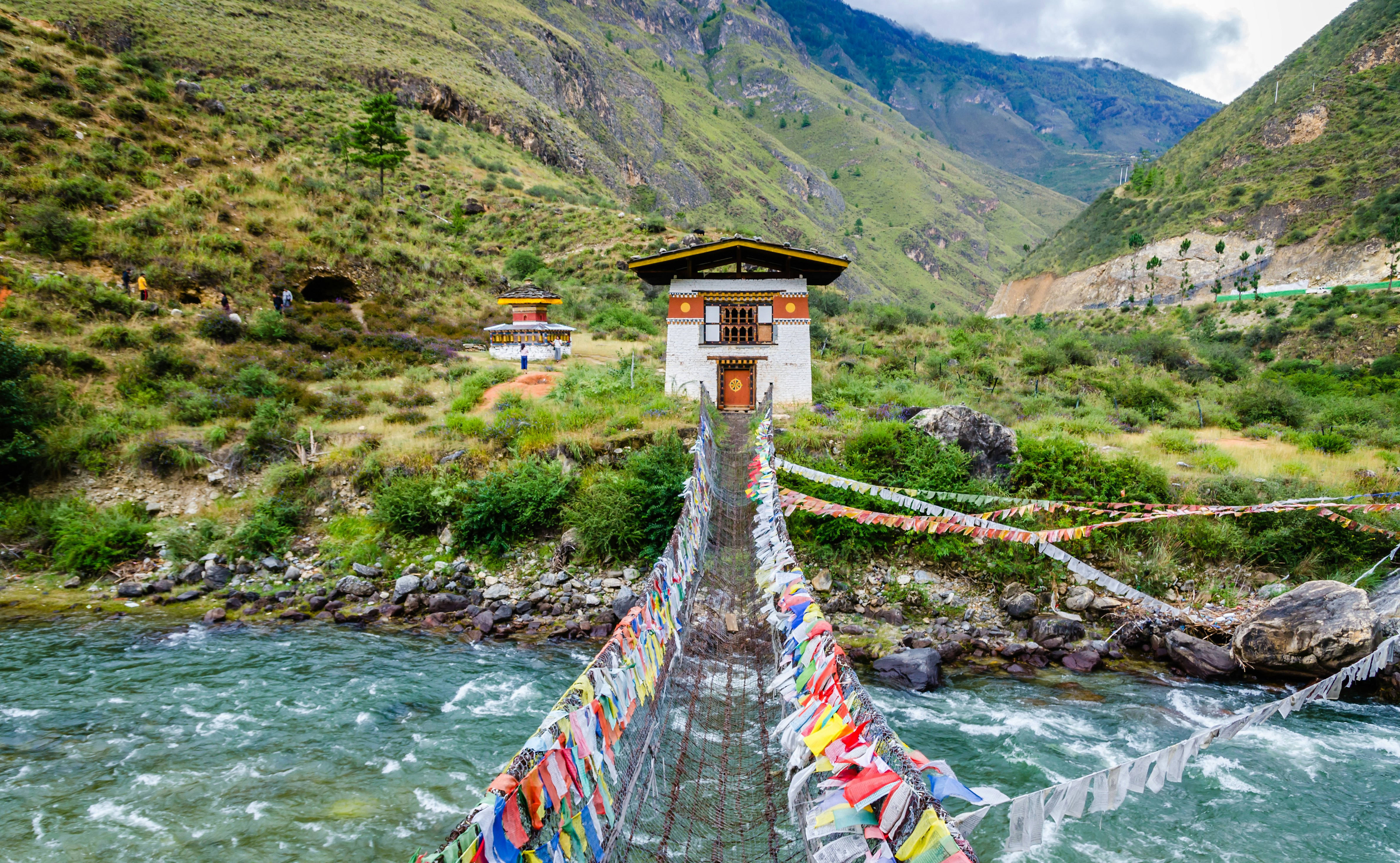
14. Paro, Bhutan
Best for a mesmerizing valley in a secluded kingdom
Surrounded by snowy mountains bathed in the warm glow of the afternoon sun, where rivers ebb and flow past cedar forests, Paro sums up the mystical Himalayan kingdom of Bhutan. Here, burning incense is a way of life, and the country's development is measured by happiness. The world’s first carbon-negative country, Bhutan aims to attract high-value, low-impact tourism while charging a of a day, which is invested in initiatives that help preserve the country’s values.
After a day hiking to Taktshang Goemba (Tiger’s Nest), a sacred monastery that clings to a dramatic cliff over 3000m above sea level, relax in a Bhutanese hot stone bath – locals believe that the water has healing powers. You can also use Paro as a base to explore the capital Thimphu, with a visit to a farmers market and to catch the light of 108 butter lamps (a sacred number for Bhutanese) at the 54m Buddha Dordenma statue, which houses over 125,000 smaller Buddhas inside it.
Planning tip: The national carrier Drukair flies into Bhutan’s international airport in Paro from Delhi, Kathmandu, Bangkok and Singapore.

15. Setouchi, Japan
Best for sun, lemons and cycling
The Inland Sea (Seto-nai-kai) borders the main Japanese islands of ±á´Ç˛Ô˛őłóĹ«, Shikoku and °˛âĹ«˛őłóĹ« and holds hundreds of smaller islands. Popularly known as Setouchi, the region receives far fewer tourists than Tokyo, Osaka and Kyoto. And for many people, the rural seaside landscapes are Studio Ghibli movies brought to life. In fact, some port towns in the region, like Tomonoura, are where animator and filmmaker Hayao Miyazaki drew inspiration for his popular films.
Perhaps nothing will prepare you for the spectacular scenery of rolling mountains, screeching seagulls soaring high up the skies and gently lapping waves as you pedal along dedicated bike paths. Along the way, stop for ice cream and fresh lemonade in Ikuchi-jima, one of Japan’s main lemon growers
Planning tip: You can use Hiroshima – home to the Peace Memorial Museum, conveying the horrors of the atomic bombing – as your base to explore the region (while benefiting from the city's exceptional dining scene), or pick the smaller seaside town Onomichi, from which a 70km cycle route known as the Setouchi Shimanami KaidĹŤ (Shimanami Sea Route) runs through a chain of small islands, connecting ±á´Ç˛Ô˛őłóĹ« with Shikoku.
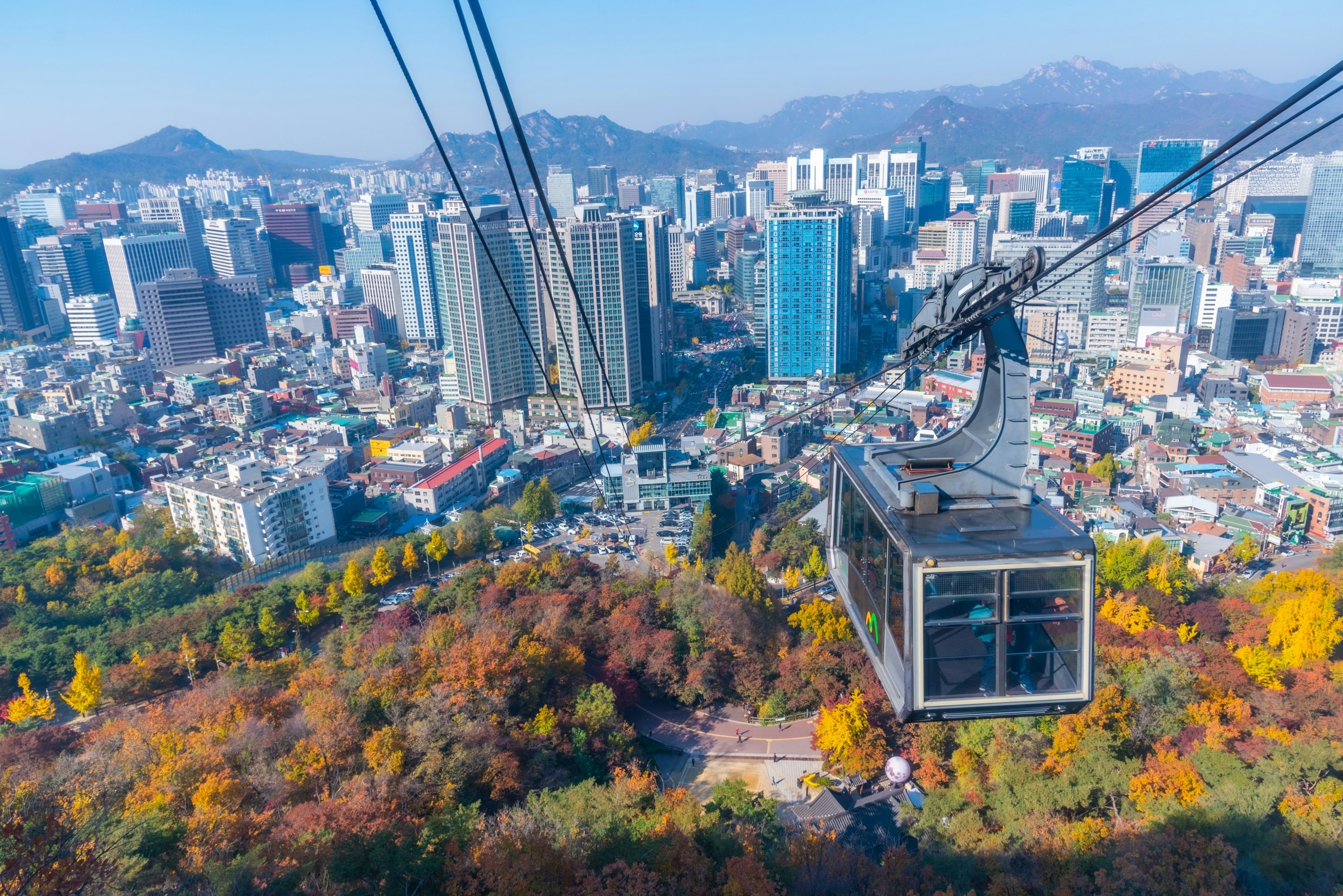
16. Seoul, South Korea
Best for a futuristic city
With AI restaurants and robot delivery services, Seoul is plush and modern at seemingly every corner but also blends fashion, culture and cuisine. Visitors should seek out South Korea’s delicious food, like tteokbokki (stir-fried rice cakes in spicy sauce) at the century-old Gwangjang Market, go shopping in Myeong-dong and hike in the Bukhansan National Park, the country’s most popular hiking destination.
Planning tip: You’ll love a night or two staying at a hanok (wooden home) in the historic Bukchon Hanok Village, where you can get a taste of the traditional way of life.

17. Siargao, the Philippines
Best for surfing
It’s fair to say that there seems to be very little to do in Siargao other than go surfing. In fact, Siargao’s year-round good waves and surf breaks first drew people (and surfers) from all over to this stunning island – some even call it the surfing capital of the Philippines.
Bobbing on a surfboard aside, you can island-hop, kayak through palm-fringed mangrove marshes and swim in aquamarine rock pools. And if none of this is right for you, it’s also the ideal place to slow down, take midday naps on a hammock and watch the sun go down with a cool drink in hand.
Planning tip: With better roads, new flight routes and luxe hotels, development has poured in, but you can still embrace local life by heading deep into the island.

18. Bali, Indonesia
Best for a tropical getaway
Whisper Bali and many travelers conjure images of a tropical getaway with coconut-palm-dotted beaches and bamboo villas with infinity pools overlooking endless rice terraces. Craving warm seas, diving, beach clubs or spectacular island scenery with rugged cliffs? You’ll find it in Bali. While parts of the island, such as Kuta and Canggu, have felt the impact of overtourism, you’ll still find local festivals, serene Hindu temples and warungs (food stalls that are part of Indonesian life) as you head inland. Try exploring the small hamlets around Ubud, or base yourself in Singaraja for a quieter getaway. Take time to chase the waterfalls hiding deep in the dense thicket and plan day trips to nearby Nusa Penida.

19. Samarkand, Uzbekistan
Best city on the Silk Road
Once home to the Timurid royals, Samarkand is enveloped in its past glory. Its striking azure-domed mosques with intricately detailed mosaic walls make this Silk Road city one of Uzbekistan’s most prominent tourist destinations. You’ll find the past everywhere you look, from the magnificent Registan, once the center of the ancient empire, to the historic Shah-i-Zinda mausoleums and silk factories where local women meticulously weave stunning carpets.
Planning tip: If road-tripping along the Silk Road is on your plans, start in Samarkand, then head to Bukhara and work your way further west.

20. Yunnan, China
Best for diversity (in cultures and landscapes)
For an indication of how diverse Yunnan is, look no further than its 51 ethnic minorities. Then look at the landscapes – soaring mountains paving the way to deep gorges and terraced paddies. You could spend months exploring this province in China’s southwest, but two weeks is enough to get a glimpse of its many attractions. Kunming – meaning “City of Eternal Spring” – is Yunnan’s modern provincial capital and is your likely first stop. From there, you can plan trips to a rice terrace and the town of Jianshui, with its Confucian temple, gardens and tea rooms, as well as the valley of Dali. There are dramatic hiking trails, too, like the trek to the scenic Tiger Leaping Gorge canyon. Near the Tibetan border is Shangri-La, with old towns, Buddhist monasteries, bustling markets and high-altitude lakes.

21. Tokyo, Japan
Best for a modern megacity
We’ll admit it: there’s nowhere like Tokyo. The Japanese capital, with its contemporary art scene, futuristic technology and Michelin-star dining, needs no introduction. Many visitors base themselves in Shinjuku (which feels like a city within the city) to easily approach a practically endless list of things to do. Check out the Tokyo National Museum, the historic Imperial Palace and ł§±đ˛Ô˛őĹŤ-Âáľ±. Roam the dark, tightly packed alleys of Shinjuku’s Golden Gai, where over 200 bars and restaurants crowd together in the tiniest bylanes, often frequented by the city’s artists. Spend half a day at the interactive art museum teamLab Borderless; plan a trip to the city’s biggest bustling wholesale market, Tsukiji; and expect to marvel at the landscaping at Rikugi-en. You’ll also need to make it across Shibuya Crossing, where hundreds of people come from all directions at once – nothing screams Tokyo more than this!

22. Hong Kong
Best for dim sum and harbor views
It doesn’t take long to fall head over heels for Hong Kong. Neon-lit alleyways are full of eat-till-you-drop street markets, rooftop bars, retro-themed clubs and some of the world’s best restaurants. Throw scenic hiking trails into the mix and you’ve landed at one of Asia’s most vibrant cities. For a quintessential Hong Kong experience – and something that almost all the tourists seem to do – take the Peak Tram to the city’s highest point. Don’t leave without sampling the dim sum, hearty bowls of wonton soup and chargrilled meat dishes.
Planning tip: On the Kowloon side, wander through the flea market on Apliu St, where locals frequent the lanes for everything electronic.

